When you care for a bonsai tree, the terracotta bonsai pots are not just a container. It’s part of the dwarf tree’s health and style. Many growers ask about traditional terracotta bonsai pots because they are made from natural, unglazed clay.
These pots have porous walls that let roots breathe, improve aeration, and allow extra water to drain. If you grow a ficus bonsai, a juniper bonsai, or even a jade bonsai.
You’ll notice how much healthier the roots look in terracotta compared to plastic bonsai pots or heavy ceramic bonsai pots.
Terracotta pots also give your tree a rustic orange or brown look that feels close to nature.
You’ll find them in all shapes, rectangular bonsai pots, oval and round styles, or even tall cascade bonsai pots for dramatic tree forms.
And whether you need a small indoor bonsai pot for a desk tree or a large patio terracotta pot for outdoor species like pine bonsai, there are options for every grower.
Today, you can buy them almost anywhere, from Amazon listings to wholesale bonsai pottery stores near you, or even used terracotta bonsai pots if you’re on a budget.
But before you decide, it’s worth knowing the pros and cons of terracotta, how to soak, clean, and protect these pots in winter, and how they compare with ceramic, mica, or glazed bonsai pots.
This way, you’ll know if a terracotta pot is the right match for your bonsai journey.
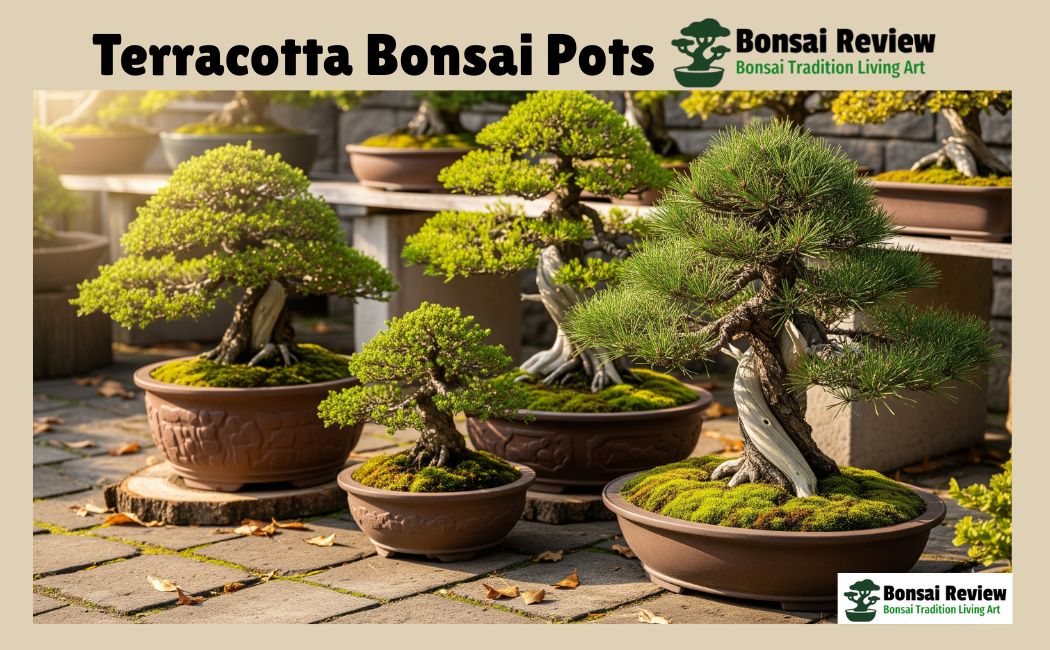
What Makes Terracotta Bonsai Pots Different?
Terracotta pots are not just regular containers, they’re made from unglazed clay that feels earthy and natural. The biggest difference is their porous walls. This means water can slowly move through the pot, giving your bonsai roots better aeration and helping prevent root rot.
Unlike smooth glazed ceramic bonsai pots, which hold more water, terracotta allows the soil to dry faster. This is great for trees like juniper bonsai or pine bonsai that love good drainage.
Another reason people choose terracotta is its look. The warm orange, brown, or red tones give your bonsai a rustic, natural style that matches outdoor gardens and patios.
If you’re training a young tree in a rectangular bonsai pot or showing off a dramatic cascade bonsai in a tall clay container, terracotta brings out the tree’s character.
Terracotta also makes great training pots because they are affordable and easy to find. You’ll often see them used before moving a tree into a more expensive Japanese bonsai pot or a handmade ceramic container.
But with these differences come new responsibilities, since terracotta dries soil faster, you’ll need to water your bonsai more often, especially if you’re growing indoor bonsai trees. That’s why knowing the pros and cons is the next step before choosing one.
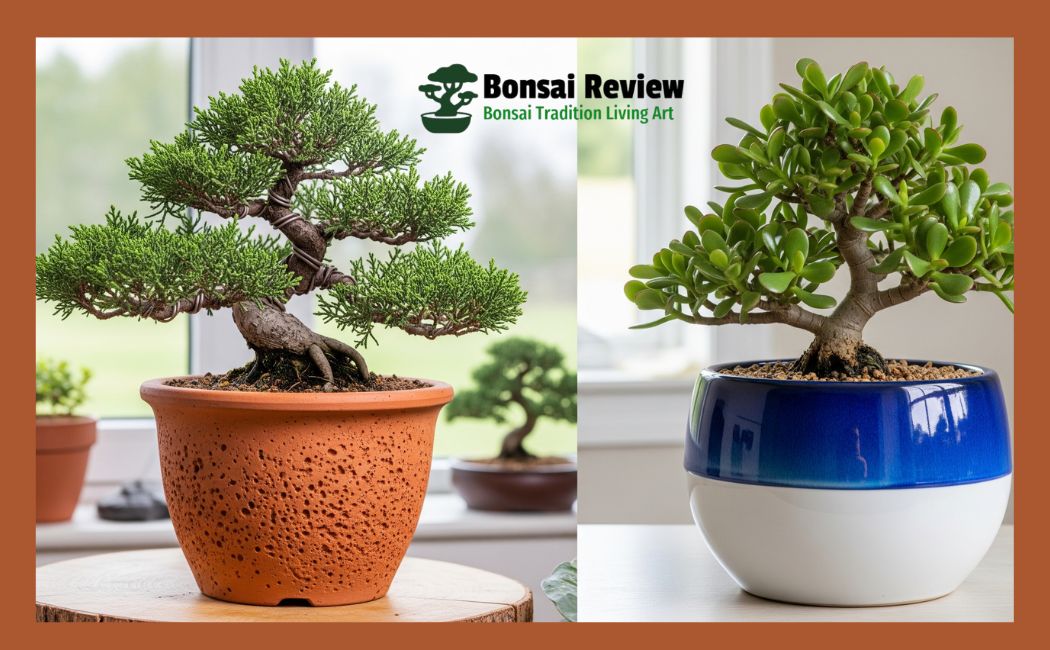
Terracotta Bonsai Pots: Benefits of Terracotta Matter for Bonsai Growth Impacts?
- Terracotta is a popular and beneficial material for the traditional art of bonsai pots, particularly for training and developing young dwarf trees. Their porous nature provides crucial advantages for root health, drainage, and temperature regulation.
- Superior Drainage and Porosity: Terracotta pots allow water and air to circulate through the unglazed clay walls. This helps prevent over-watering and keeps the soil from becoming waterlogged, which is a major concern for bonsai.
- Healthy Root Growth: The pot’s rough texture and breathability encourage the development of a healthy and fibrous root system, which is essential for bonsai growth.
- Moisture Regulation: The clay’s porous nature wicks excess moisture from the soil, allowing the soil to dry more evenly and quickly than with glazed or plastic pots.
- Temperature Control: The porous clay also helps regulate soil temperature, keeping the root system cooler during hot weather.
- Earthy Aesthetic: The classic, unglazed reddish-brown color of terracotta provides a natural, earthy look that complements many bonsai trees.
- Ideal for training: Because they are inexpensive and promote rapid, healthy root growth, terracotta pots are often used as “training pots” while a bonsai is still in development.
Considerations for Using Terracotta Bonsai Pots.
- Dries out quickly: The high porosity of terracotta means the soil dries out faster, especially in warmer climates. This requires more frequent watering compared to other pot types.
- Not all are weather-resistant: Standard terracotta is fired at a lower temperature and may crack or break in freezing temperatures. For outdoor use in cold climates, look for specific, high-fired, frost-resistant varieties such as some Japanese terracotta or Italian Impruneta to prevent damage.
- Not for moisture-loving species: Plants that prefer constantly moist soil, such as ferns, may not thrive in terracotta pots because they can dry out too quickly.
Where to Find Terracotta Bonsai Pots?
- Bonsai Specialty Retailers: Shops that specialize in bonsai often sell terracotta training pots, which are specifically designed for the proper growth and development of bonsai trees.
- Garden Supply Stores: Many garden supply centers and nurseries carry terracotta pots in various sizes and shapes.
- Online Marketplaces: Websites like Amazon and specialty gardening sites offer a wide range of terracotta bonsai pots, often with drainage holes and accompanying trays.
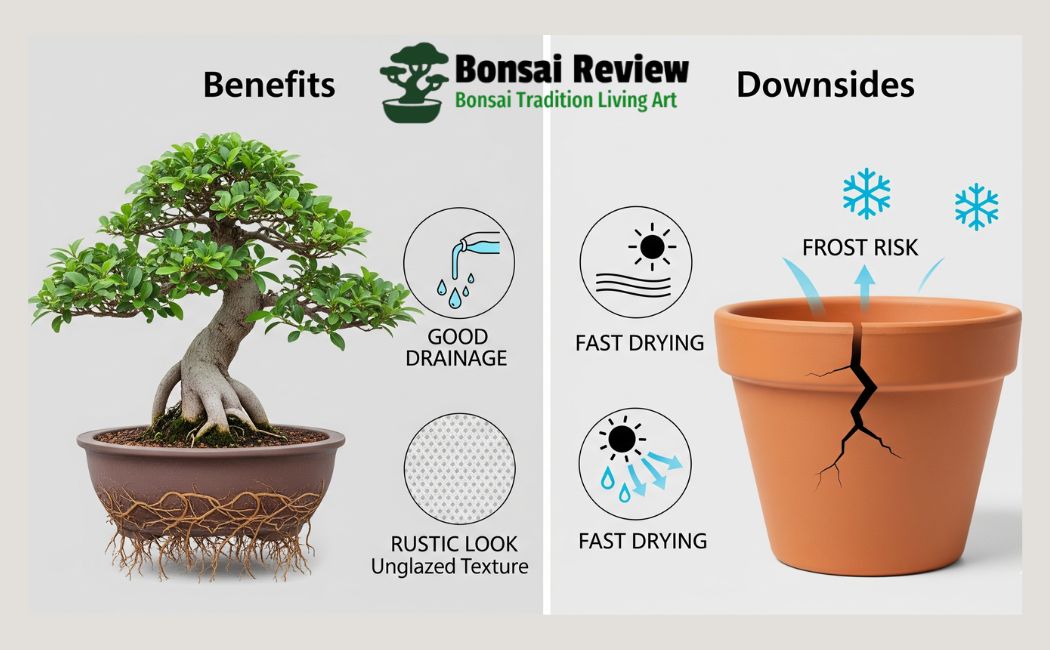
What Are the Pros and Cons of Terracotta Bonsai Pots?
Every bonsai grower wants a pot that looks good and keeps the tree healthy. Terracotta has many benefits, but it also comes with some downsides you should know.
| Pros of Terracotta Bonsai Pots | Cons of Terracotta Bonsai Pots |
| Made from natural, unglazed clay | Can crack in frost or sudden cold |
| Porous walls improve aeration | Soil dries out faster, needs more watering |
| Prevents root rot by draining extra water | Can build up white salt deposits |
| Rustic orange, brown, and red tones give a natural look | May grow green algae on the surface |
| Available in many shapes (rectangular, oval, cascade) | Fragile if dropped or hit |
| Affordable, even under $15 or wholesale | Heavier than plastic pots, harder to move |
| Great for training pots before display | Less decorative than glazed ceramic bonsai pots |
Why Terracotta Bonsai Pots Matter for Indoor Plants?
If your bonsai is a ficus, juniper, pine, or jade tree, terracotta can help the roots stay strong and healthy. But if you grow bonsai indoors or don’t water often, the soil may dry too fast. In that case, you might prefer ceramic or glazed bonsai pots.
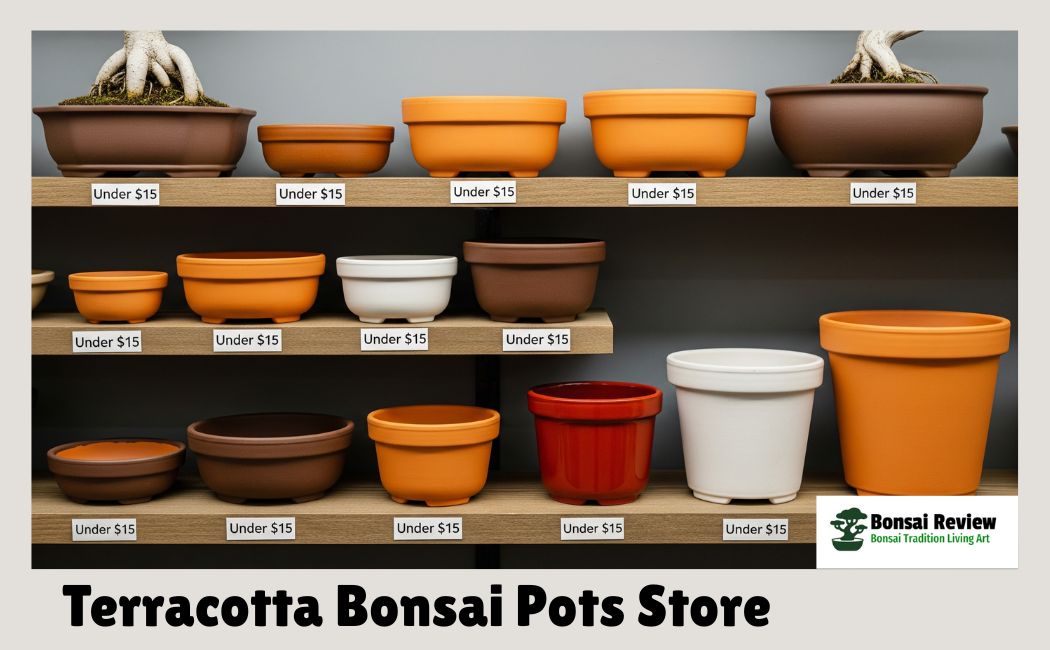
How Do You Choose the Right Terracotta Bonsai Pot?
Not every bonsai tree fits in the same type of pot. The shape, size, and depth of your terracotta bonsai pots will affect how your dwarf tree grows and how healthy its roots stay.
1. Match Pot Shape to Bonsai Style;
- Rectangular and oval pots are great for formal upright or informal upright bonsai styles.
- Round pots are often used for softer, natural-looking bonsai, like ficus bonsai.
- Cascade bonsai pots (tall and deep) are perfect for dramatic cascade or semi-cascade styles.
- Shallow bonsai pots highlight surface roots and are common for pine or juniper bonsai.
2. Pick the Right Pot Size;
- Small terracotta bonsai pots are best for young indoor bonsai or training pots.
- Medium and long pots suit most mature bonsai trees that need balance.
- Large terracotta bonsai pots are ideal for outdoor bonsai or species with strong root systems.
- Tall bonsai pots are made for cascade or semi-cascade trees.
- Box and patio terracotta pots are useful for bigger bonsai displays outdoors.
3. Choose a Color That Fits Your Tree;
Terracotta bonsai pots usually come in warm, earthy tones, but you can also find them in different shades:
- Orange and brown traditional, rustic look.
- Red or pink pots stand out and add a bold touch.
- White terracotta bonsai pots give a clean, modern style.
4. Think About Where You’ll Place Terracotta Bonsai Pots?
- Indoor bonsai: Choose a pot that won’t dry out the soil too quickly. Smaller, deeper pots help.
- Outdoor bonsai: Wide or large terracotta pots work best, but remember to protect them from frost.
Should You Use Terracotta Pots for Indoor or Outdoor Bonsai?
Terracotta bonsai pots can work both indoors and outdoors, but the results are different depending on where you place your tree.
1. Indoor Bonsai in Terracotta Pots
If you’re growing an indoor bonsai tree like a ficus bonsai or jade bonsai, a terracotta bonsai pot can help keep roots healthy because the porous clay walls allow fresh air to reach the soil.
But there’s one challenge: terracotta dries soil much faster than ceramic or glazed bonsai pots. Inside your home, where the air is drier, this means you’ll need to water more often to stop the soil from becoming too dry.
Some growers use small or medium terracotta bonsai pots indoors as training pots, since they are affordable and easy to replace. If you choose this option, remember to soak the pot before use and check for drainage holes so extra water doesn’t sit around the roots.
2. Outdoor Bonsai in Terracotta Pots
For outdoor bonsai species like pine bonsai or juniper bonsai, terracotta is a natural fit. The quick drainage helps protect against root rot, especially during rainy seasons.
Large and patio terracotta bonsai pots give trees enough space to spread their roots while keeping the natural, rustic look that blends well with gardens.
The main risk outdoors is frost damage. Terracotta can crack in freezing weather, so in winter you’ll need to move your pots to a protected area or wrap them to keep them safe. Some growers also seal terracotta pots to slow down water absorption and reduce the risk of frost cracks.
Quick Tip for Your Terracotta Bonsai Pots: Environment-friendly.
- Use deep or tall terracotta pots if your bonsai dries out too fast indoors.
- For outdoor bonsai, choose large or box-style pots and protect them during cold months.
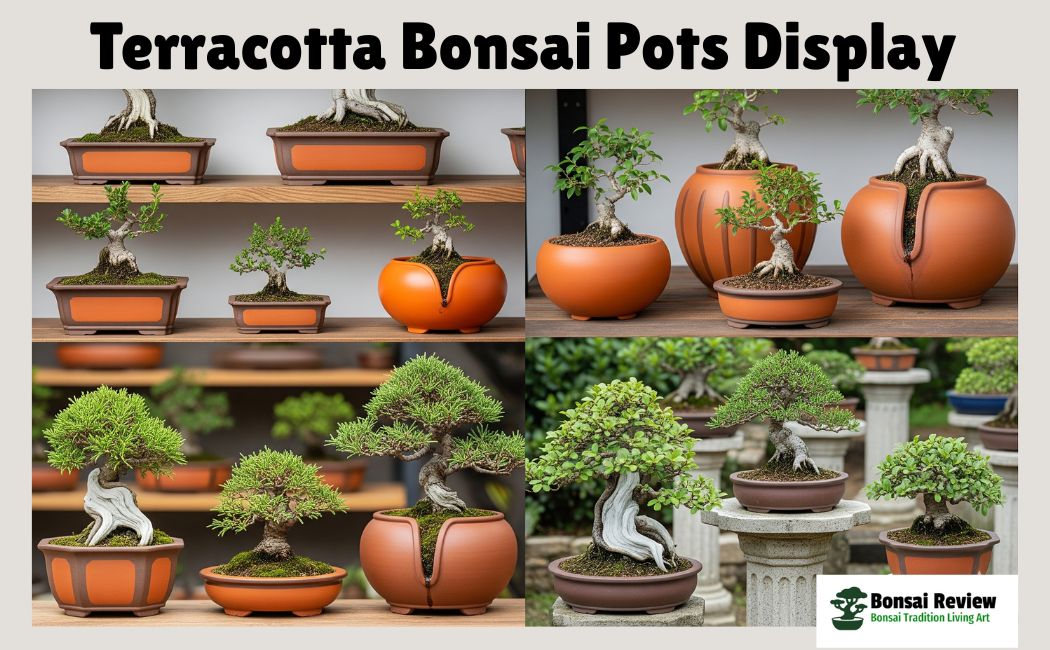
Terracotta vs Other Bonsai Pots: Which One Should You Choose?
When you shop for a bonsai pot, you’ll see many options: terracotta, ceramic, glazed, mica, and even plastic pots. Each one has its own strengths and weaknesses. Let’s compare them so you can pick what fits your bonsai and lifestyle best.
Terracotta Bonsai Pots: Comparing Bonsai Pot Materials
| Pot Type | Key Features | Best For | Watch Out For |
| Terracotta Bonsai Pots | Made from unglazed clay, porous, allows aeration and quick drainage, earthy tones (orange, red, brown, white). | Outdoor bonsai, like pine bonsai and juniper bonsai. Good as training pots. | Soil dries faster, needs frequent watering, and can crack in frost. |
| Glazed Ceramic Bonsai Pots | Non-porous, holds moisture longer, available in many colors and designs. | Indoor bonsai trees, display bonsai, or species that prefer steady moisture like ficus bonsai. | It can cause root rot if overwatered. Heavier and more expensive. |
| Mica Bonsai Pots | Lightweight, durable, frost-resistant, not porous. | Beginners or growers in cold climates. | Less natural look compared to terracotta or ceramic. |
| Plastic Bonsai Pots | Cheap, lightweight, good for beginners. | Training bonsai or for temporary use. | Poor airflow can overheat roots in the hot sun, which doesn’t give a traditional bonsai look. |
Why Terracotta Still Stands Out?
Even with these options, terracotta stays popular because of its natural style, affordability, and the way it supports root health through aeration. While glazed ceramic bonsai pots may look fancier, terracotta gives you a practical balance, especially if you’re still shaping your tree in its early years.
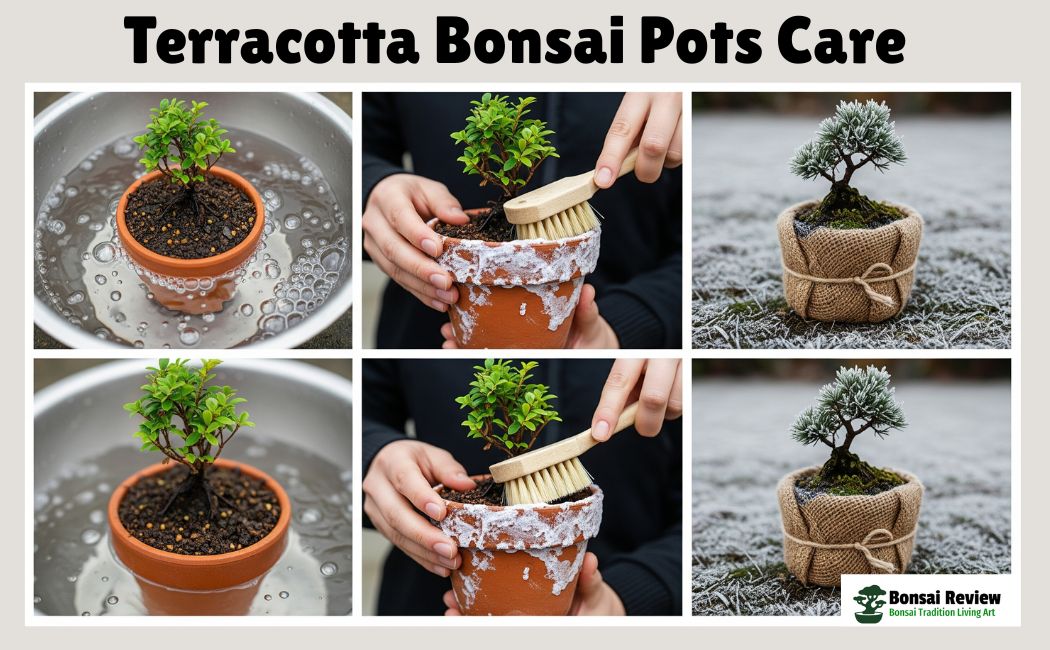
How Do You Care for Terracotta Bonsai Pots the Right Way?
Terracotta bonsai pots are strong and natural, but they need some care to stay in good shape. With the right steps, you can stop problems like cracks, salt stains, and fast soil drying, while keeping your bonsai roots safe.
Watering & Moisture Balance:
- Terracotta is porous, so it dries out faster than glazed bonsai pots.
- Check the soil daily, especially with indoor bonsai trees like ficus or jade bonsai.
- For outdoor bonsai species such as juniper or pine bonsai, water deeply, but make sure water drains out through the drainage holes.
Cleaning Terracotta Bonsai Pots:
- Over time, you may notice white salt deposits on the surface. This comes from minerals in water and fertilizer.
- Scrub gently with a brush and warm water; avoid harsh chemicals.
- If you’re reusing a pot as a training pot, clean it fully before planting a new tree to stop disease transfer.
Protecting Against Frost & Cracks in Terracotta Bonsai Pots
- In cold weather, terracotta can crack because water in the clay expands when frozen.
- Move your pots to a sheltered spot in winter or wrap them with burlap for insulation.
- Some bonsai growers seal terracotta pots inside with a natural sealant to slow water absorption.
Seasonal Care Tips for Terracotta Bonsai Pots.
- Spring/Summer: Water often, especially for small and shallow terracotta bonsai pots.
- Autumn: Reduce watering but keep the soil slightly moist.
- Winter: Protect from frost, but don’t let the soil go bone dry.
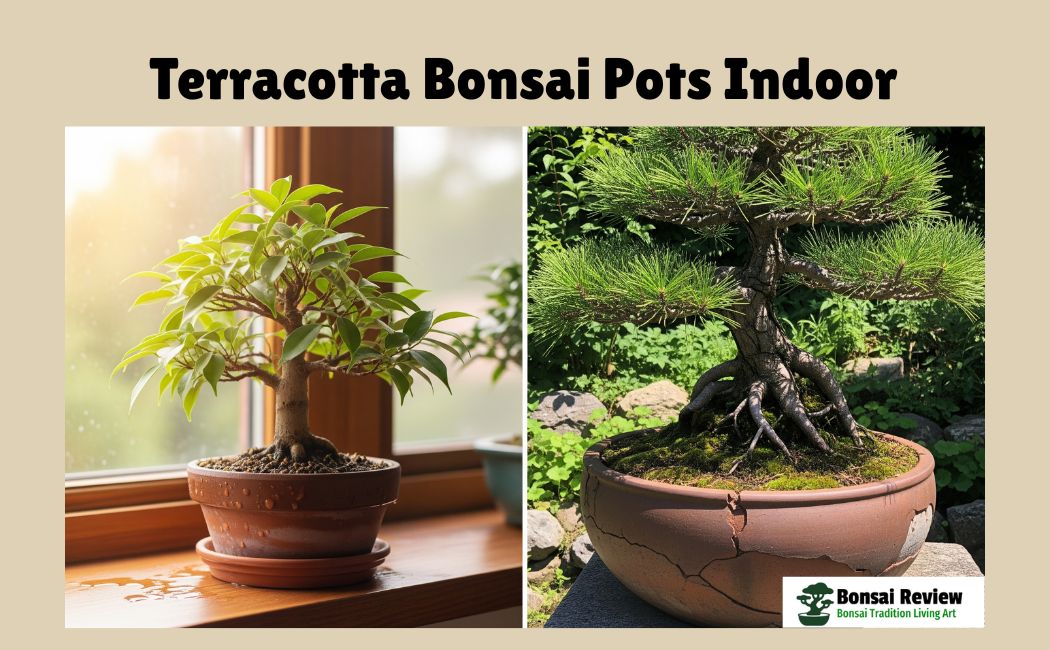
What Should You Look for When Buying Terracotta Bonsai Pots?
When you shop for a bonsai pot, it’s not only about looks. The right terracotta bonsai pot will support your tree’s roots, growth, and style. Here’s a guide to help you choose wisely.
1. Size & Depth Matter: Terracotta Bonsai Pots
- A shallow terracotta bonsai pot is ideal for mature trees and helps control root spread.
- A deeper rectangular pot works well for younger or fast-growing bonsai that need more soil.
- Always match the pot size to the bonsai species. For example, a juniper bonsai can handle shallower pots, while a Ficus bonsai prefers deeper soil.
2. Shapes & Styles: Best Traditional Japanese Terracotta Bonsai Pots
- Rectangular pots: Good for strong, upright bonsai.
- Oval or round pots: Better for soft, flowing styles.
- Cascade pots: Tall and narrow, perfect for dramatic cascade bonsai designs.
- Training pots: Simple, affordable terracotta used in early shaping stages.
3. Colors & Aesthetics: Terracotta Bonsai Pots in the United States.
Terracotta usually comes in orange, red, brown, or white clay tones. These natural shades highlight the trunk and foliage, giving your tree a rustic charm. If you want more design freedom, you might compare with glazed ceramic bonsai pots in blue, green, or cream.
4. Price & Value: Terracotta Bonsai Pots in the USA.
- Terracotta bonsai pots are affordable, often cheaper than Japanese ceramic bonsai pots.
- Because they’re sturdy, they last for years if cared for properly.
- For beginners, it’s smart to start with a terracotta training pot before investing in an expensive handmade ceramic bonsai pot.
5. Practical Features to Check for Tettacotta Bonsai Pots Care.
- Drainage holes are a must to prevent waterlogging and root rot.
- Look for pots with wiring holes so you can secure the bonsai in place.
- Check the thickness thin terracotta cracks faster in cold climates, while thicker pots are more durable.
Conclusion: Are Terracotta Bonsai Pots the Right Choice for You?
If you want a pot that feels natural, breathable, and timeless, then terracotta bonsai pots are a smart choice. They keep roots healthy with good airflow, fit many bonsai styles like juniper, pine, ficus, and jade, and bring a warm, earthy charm to your display.
Yes, terracotta dries faster than glazed ceramic bonsai pots, and it can crack in freezing weather. But with the right watering routine, seasonal care, and protection, you can enjoy both beauty and durability.
For beginners, terracotta works perfectly as training pots, affordable and practical. For seasoned growers, they add an authentic, rustic look that highlights the art of bonsai.
So, if you’re just starting your bonsai journey or refining a masterpiece, choosing terracotta means you’re bringing your tree closer to nature, while keeping both style and function in balance.
Helpful article: What Makes USA-made Bonsai Pots with Handmade Unique Designs?
FAQs: What Makes Terracotta Bonsai Pots Better Than Ceramic or Plastic Pots?
1. Are terracotta pots good for bonsai?
Yes. Terracotta bonsai pots are porous and breathable, which means roots get plenty of oxygen and avoid waterlogging. They’re especially good for juniper, Ficus, and pine bonsai trees that prefer drier soil.
2. What plants should not be in terracotta pots?
Dwarf plants that love constant moisture, such as ferns or tropical bonsai that need high humidity, may dry out too quickly in terracotta. For these, a glazed ceramic bonsai pot may be better.
3. What is the downside of terracotta bonsai pots?
The main downsides of terracotta bonsai pots are it’s dry out faster than plastic or glazed pots. They can crack in freezing weather. Also are heavier and fragile, so they need careful handling.
4. Do terracotta bonsai pots need drainage holes?
Yes. Drainage holes are essential for bonsai health. Without them, water can pool in the pot, leading to root rot. Most terracotta bonsai pots come with pre-drilled holes.
5. Are terracotta bonsai pots better for indoors or outdoors?
Both. For outdoor bonsai, terracotta blends naturally with the garden. For indoor bonsai, such as a small ficus or jade, terracotta works well but may require more frequent watering.
6. Can I find terracotta bonsai pots at affordable prices?
Yes. You can get terracotta bonsai pots under $15, especially online or at local garden stores. If you want larger or specialty designs like cascade bonsai pots, they may cost more.
7. Why is Terracotta so Expensive?
Clay pots are expensive for several reasons for the quality of raw materials, the labor-intensive production process, and the growing demand for sustainable and artisanal products. By understanding these factors, consumers can appreciate the craftsmanship and value that go into each pot.
8. Do terracotta pots change the look of bonsai displays?
Absolutely! Terracotta bonsai pots have a warm, rustic, natural color that enhances traditional bonsai displays. They highlight the tree’s trunk, roots, and moss, giving an authentic Japanese feel.
9. Which plants don’t like terracotta pots?
Many dwarf plants that don’t thrive in Terracotta bonsai pots for indoors, like Ferns, Peace lilies, Calatheas, Alocasia, etc. Most tropical plants require high humidity on the roots.
10. Which is Better For Terracotta or Clay pots?
Red clay pots, with their moisture-retaining capabilities, are best suited to plants that prefer constantly damp conditions, such as ferns or begonias, while Terra cotta pots, with their excellent drainage features, are great choices for succulents, cacti, and herbs that need well-aerated soil conditions.